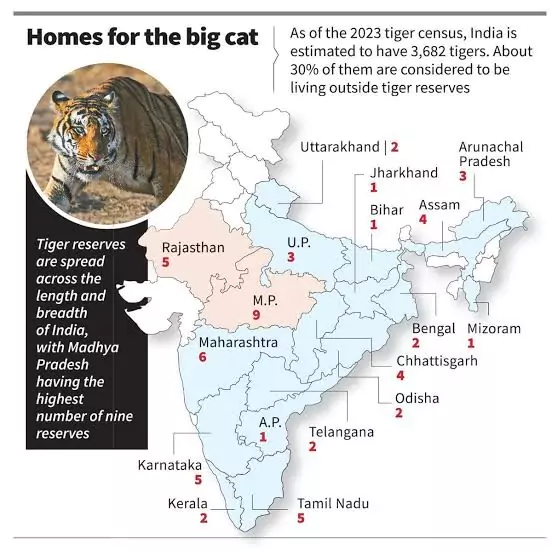Tiger Reserves
On March 9, the Environment Minister announced that the centre had declared the Madhav National Park in Madhya Pradesh as the country's 58th tiger reserve. This is the 9th tiger reserve in the state, the highest among the states. Maharashtra has six. Rajasthan, Tamil Nadu, Karnataka have 5 each.
Why Tiger Reserve?
While tigers were historically abundant in India, hunting, poaching and the Colonial exploitation of forests for timber started a precipitous decline in the early 20th century. Their numbers in the early 20th century.
It was estimated in 1964 that there would have been around 40000 tigers in the country at the turn of the 20th century.

By 1960s, these numbers were down to between 2000 and 4000, attributed to wanton hunting aided by a proliferation of gun licences issued in the years following 1947, improved access to the forest, clearing of large tracts of forests for various purposes, mushrooming of the new businesses of “shikhar Companies” and fur trade.
Following an alarm raised by naturalists, the Indian Board for Wild Life (IBWL) , the earlier avatar of The National Board for wild life in a meeting in New Delhi in July 1969 recommended a total ban on the export of all wild cat skins, including tigers.
The same year the 10th Assembly of the International Union for Conservation of Nature met in Delhi and included the tiger in its Red Data Book- as an endangered species and adopted a resolution calling for a ban on the Killing of tigers.
On April 1, 1973, Project Tiger was inaugurated at Corbett tiger reserve with 9 tiger reserves-
- Corbett (then in UP, now in Uttarakhand)
- Palamau (then in Bihar, mow in Jharkhand)
- Simlipal (Odisha)
- Sundarbans (West Bengal)
- Manas (Assam)
- Ranthambore (Rajasthan)
- Kanha (Madhya Pradesh)
- Melghat (Maharashtra)
- Bandipur (Karnataka)
The Project Tiger guidelines made it mandatory for every tiger reserve to be managed in accordance with a site-specific management plan. It laid down the concept of establishing a Core zone and a Buffer zone.
Why is Madhav National Park?
With an estimated area of 165.32 sq km, it was first notified as an National Park in Madhya Pradesh in 1956. Now the Madhav National Park and tiger reserve has a Core area of 355 sq km, with a buffer tone of 4-6 Sar km. It did not have a tiger population till 2023, when a male tiger and two females were relocated there. Today, by March 2025, the population has grown to 7.
Madhav Reserve is an important Connecting Corridor to the Ranthambore Tiger Reserve in Rajasthan. It is also connected to Kuno National Park, which now has a Captive Cheetah population.
Madhya Pradesh boasts several prominent tiger reserves, such as Kanha, Panna, Bandhavgarh.
Due to successful Conservation strategies, the stale has the highest number of tigers (785)
There are plans to introduce lions from Gir in Gujarat into Kuno National Park, after the supreme court green-lit the project.













